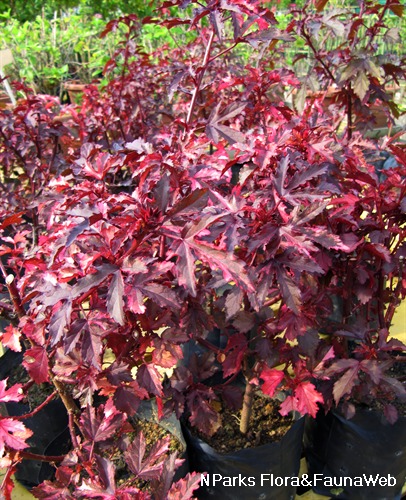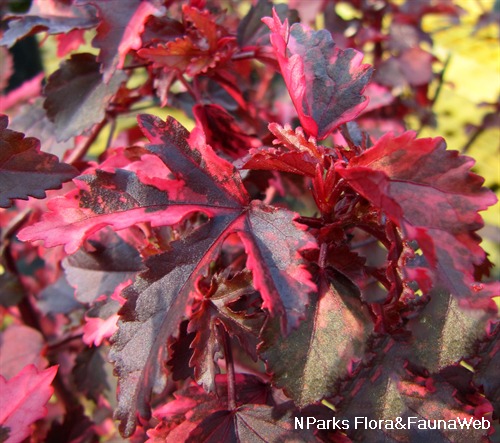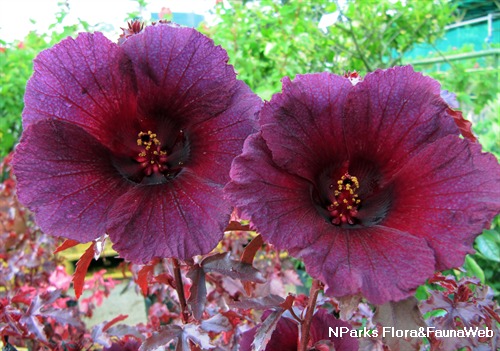
Name
Classifications and Characteristics
| Plant Division | Angiosperms (Flowering Seed Plants) (Dicotyledon) |
|---|---|
| Plant Growth Form | Shrub |
| Lifespan (in Singapore) | Perennial |
| Mode of Nutrition | Autotrophic |
| Plant Shape | Shrubby |
| Maximum Height | 2 m |
Biogeography
| Native Distribution | Tropical Africa |
|---|---|
| Preferred Climate Zone | Tropical |
Description and Ethnobotany
| Growth Form | Erect annual or short-lived perennial herb or shrub that grows to 0.5 – 2.5 m tall, usually entirely red or with a marked red flush. |
|---|---|
| Foliage | Simple alternate leaves are slightly glossy and pubescent, deep red in colour and shape of lower leaves is usually shallowly to deeply palmately with 3 to 5 lobes but upper leaves are become undivided, with a distinct nectary located at base of midrib. Petiole dark red. |
| Flowers | Flowers are solitary and bisexual, borne between the leaf axils with five petals that are pink in colour and lasting only a day. Petals are wine red with a dark purple centre, giving the flower a distinctive “eye” in the center. Self-pollination most commonly occurs for the flowers of H. acetosella but outcrossing by insects may occur too. |
| Fruit | Fruit a red ovoid capsule that is many-seeded. Seeds reniform (= kidney-shaped) to globular, dark brown when ripe, and verruculose (= minutely verrucose, i.e. bearing wart-like projections on the surface). |
| Cultivation | Red forms are popular ornamentals that are also grown in the temperate regions as frost-tender annuals. Grows on all kind of soils, but requires good drainage. A cultivar, H. acetosella ‘Red Shield’, has brilliant maroon leaves.Propagated by seed and stem cuttings. Diseases that are known to affect H. acetosella are soilborne diseases, such as Rhizoctonia solani and Sclerotium rolfisii. |
| Ethnobotanical Uses | Food (Fruit or Vegetable) |
Landscaping Features
| Desirable Plant Features | Ornamental Foliage, Ornamental Fruits |
|---|---|
| Landscape Uses | Container Planting, Flowerbed / Border, Hedge / Screening, Focal Plant |
Fauna, Pollination and Dispersal
| Pollination Method(s) | Abiotic (Self-Pollinated) |
|---|
Plant Care and Propagation
| Light Preference | Full Sun |
|---|---|
| Water Preference | Moderate Water |
| Plant Growth Rate | Moderate |
| Rootzone Tolerance | Fertile Loamy Soils, Well-Drained Soils, Easy to Grow, Disease / Pest Resistant |
| Maintenance Requirements | Low |
| Propagation Method | Seed, Stem Cutting |
Foliar
| Foliage Retention | Evergreen |
|---|---|
| Mature Foliage Colour(s) | Red, Purple |
| Prominent Young Flush Colour(s) | Red |
| Foliar Type | Simple / Unifoliate |
| Foliar Arrangement Along Stem | Alternate |
| Foliar Attachment to Stem | Petiolate |
| Foliar Shape(s) | Non-Palm Foliage (Palmate) |
| Foliar Venation | Palmate |
| Foliar Margin | Palmately Lobed |
| Foliar Apex - Tip | Acute |
| Foliar Base | Truncate / Square |
| Typical Foliar Area | Microphyll ( 2.25cm2 - 20.25 cm2 ) |
| Leaf Area Index (LAI) for Green Plot Ratio | 4.5 (Shrub & Groundcover - Dicot) |
| Mature Foliage Colour(s) Remarks | The variegated leaves are pinkish red and dark purple. |
Floral (Angiosperm)
| Flower & Plant Sexuality | Bisexual Flowers |
| Flower Colour(s) | Pink |
|---|---|
| Flower Texture(s) | Wrinkled |
| Flower Grouping | Solitary |
| Flower Location | Axillary |
| Flower Symmetry | Radial |
| Individual Flower Shape | Funnelform / Funnel-shaped |
| Ovary Position | Superior / Hypogynous |
| Flower Lifespan on Plant | 1 Day |
| Flowering Habit | Polycarpic |
Fruit, Seed and Spore
| Mature Fruit Colour(s) | Brown, Red |
|---|---|
| Mature Fruit Texture(s) | Bristly |
| Fruit Classification | Simple Fruit |
| Fruit Type |
Image Repository
Others
| Master ID | 31380 |
|---|---|
| Species ID | 5777 |
| Flora Disclaimer | The information in this website has been compiled from reliable sources, such as reference works on medicinal plants. It is not a substitute for medical advice or treatment and NParks does not purport to provide any medical advice. Readers should always consult his/her physician before using or consuming a plant for medicinal purposes. |




.jpg)
